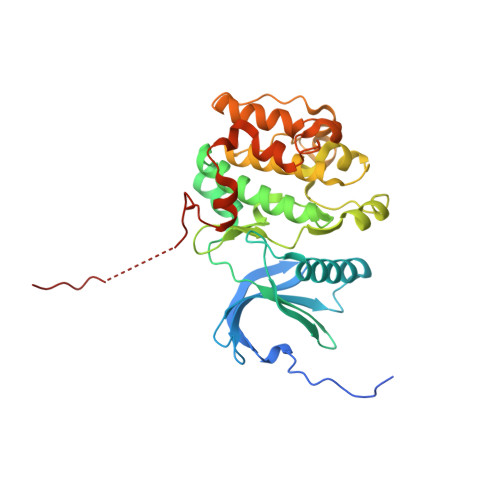Novel potent and selective inhibitors of p90 ribosomal S6 kinase reveal the heterogeneity of RSK function in MAPK-driven cancers.
Aronchik, I., Appleton, B.A., Basham, S.E., Crawford, K., Del Rosario, M., Doyle, L.V., Estacio, W.F., Lan, J., Lindvall, M.K., Luu, C.A., Ornelas, E., Venetsanakos, E., Shafer, C.M., Jefferson, A.B.(2014) Mol Cancer Res 12: 803-812
- PubMed: 24554780
- DOI: https://doi.org/10.1158/1541-7786.MCR-13-0595
- Primary Citation of Related Structures:
4NUS - PubMed Abstract:
The p90 ribosomal S6 kinase (RSK) family of serine/threonine kinases is expressed in a variety of cancers and its substrate phosphorylation has been implicated in direct regulation of cell survival, proliferation, and cell polarity. This study characterizes and presents the most selective and potent RSK inhibitors known to date, LJH685 and LJI308. Structural analysis confirms binding of LJH685 to the RSK2 N-terminal kinase ATP-binding site and reveals that the inhibitor adopts an unusual nonplanar conformation that explains its excellent selectivity for RSK family kinases. LJH685 and LJI308 efficiently inhibit RSK activity in vitro and in cells. Furthermore, cellular inhibition of RSK and its phosphorylation of YB1 on Ser102 correlate closely with inhibition of cell growth, but only in an anchorage-independent growth setting, and in a subset of examined cell lines. Thus, RSK inhibition reveals dynamic functional responses among the inhibitor-sensitive cell lines, underscoring the heterogeneous nature of RSK dependence in cancer. Two novel potent and selective RSK inhibitors will now allow a full assessment of the potential of RSK as a therapeutic target for oncology.
Organizational Affiliation:
Authors' Affiliations: Novartis Institutes for BioMedical Research, Emeryville, California; and 2Shanghai Haiyan Pharmaceutical Technology Co., Ltd., Shanghai.















